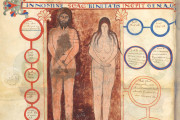A work of singular achievement in French Romanesque art, the Saint-Sever Codex is the only surviving illustrated copy of Beatus of Liébana’s commentary on the Apocalypse to have been produced north of the Pyrenees. It was written and decorated in the third quarter of the eleventh century at the behest of Gregory de Montaner, abbot of the Benedictine monastery of Saint-Sever. Whether made at the monastery is less certain, but the manuscript unquestionably is of southwestern French origin. The copiously illustrated volume includes nearly a hundred miniatures, genealogical tables enhanced with painted scenes, and many decorated initials.
The manuscript's text comprises the biblical book of the Apocalypse accompanied by a commentary by Beatus of Liébana (d. 798); Saint Jerome's commentary on the Old Testament book of Daniel; a treatise on the virginity of Mary, mother of Jesus by Saint Ildefonsus (d. 667); and copies of charters of importance to the abbey of Saint-Sever, added later in the eleventh century.
Painting Apocalyptic Anxiety
The manuscript's decoration comprises seven double-page miniatures; another three that occupy a whole page plus a portion of the facing page; thirty-six full-page miniatures; and thirty-five vignettes illustrating key events of the Apocalypse. Sixteen more images have been excised. There are also fourteen pages of a biblical genealogy elaborated with medallions and panels containing historical scenes or portraits, framed within arcades or decorative bands.
Such an elaborate program required a team of artists. The work was coordinated by an artist of considerable experience (identified in an inscription as Stephanus Garsia), who made all the underdrawings and painted some miniatures. He was assisted by two painters. The collaborative nature accounts for the visual homogeneity of the illumination.
The style of the paintings follows the Leonese Beatus tradition marked by vivid colors, frenetic energy, stylized compositions, and lurid details appropriate to the apocalyptic subject. The sophisticated approach to pictorial space and the quality of the draftsmanship, however, reflect contemporary French Romanesque advancements.
Collaboration in a Romanesque Scriptorium
Most of the Latin text was written in Caroline Minuscule by two scribes, the first working alongside the main designer and one of the assistant painters, and the second working alongside the other assistant painter. Work was divided among the teams of scribes and illuminators by physical units of parchment, suggesting a highly collaborative production process. Other scribes made smaller contributions.
From Monastic to National Treasure
The Saint-Sever Beatus was destined for an important role in the abbey's library, as attested by the prominent position given to the church of Saint-Sever in the mappa mundi (fols. 45bis verso-46ter recto) and by the transcription of monastic charters on blank folios.
It is not known when or how the Beatus left Saint-Sever. At the end of the sixteenth century, it was owned by Mathurin Brin, and in the early seventeenth century Guillaume Guerry gave it to François d’Escoubleau de Sourdis (1575-1628). The manuscript passed into the ownership of his brother, Charles d’Escoubleau (1588-1666), Marquis de Sourdis, who had it bound in mottled calf with his arms on the front cover.
Marc Antoine René de Voyer (1722-1787), Marquis de Paulmy and Marquis d’Argenson purchased it in 1769 from Louis-Jean Gaignat. The volume entered the French royal library in 1790, which was absorbed in 1792 by the newly founded Bibliothèque nationale (now Bibliothèque nationale de France).
The mappa mundi was excised from the manuscript at an unknown date. It was purchased by the Cabinet de géography of the imperial library in 1866 and has since been restored to its place in the codex.
_____
For more information on the Beatus model, read our blog article by Amy R. Miller (PhD, Medieval Art History, University of Toronto).
We have 4 facsimiles of the manuscript "Beatus of Liébana - Saint-Sever Codex":
- Beato de Liébana, códice de Saint-Sever ("Pergamenata" Edition) facsimile edition published by Patrimonio Ediciones, 2012
- Beato de Saint-Sever facsimile edition published by Club Bibliófilo Versol, 2010
- El "Beato" de Saint-Sever facsimile edition published by Edilan, 1984
- Beato de Liébana, códice de Saint-Sever (Gold Edition) facsimile edition published by Patrimonio Ediciones, 2012













